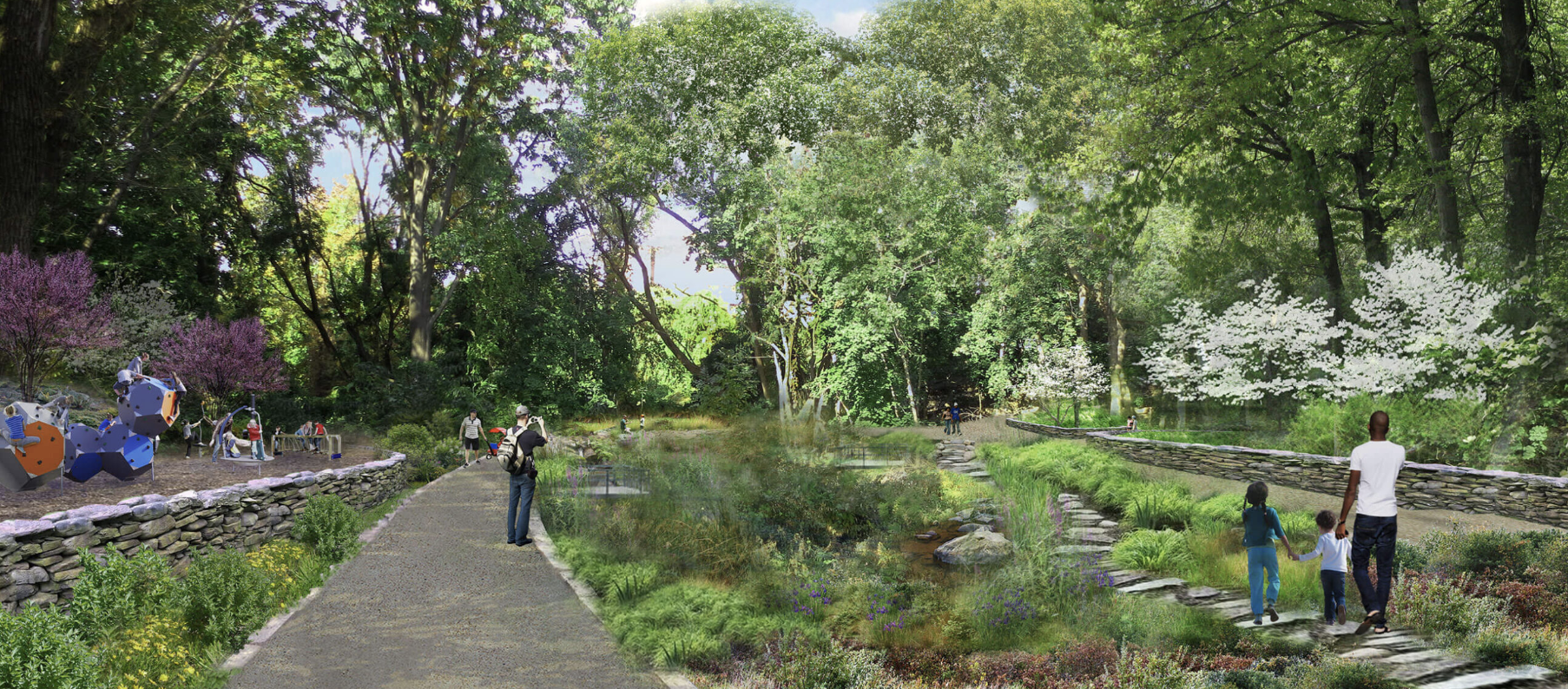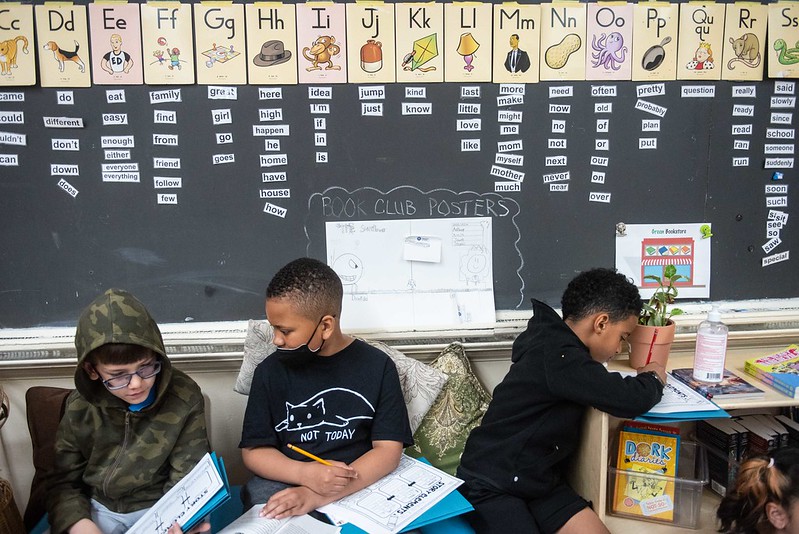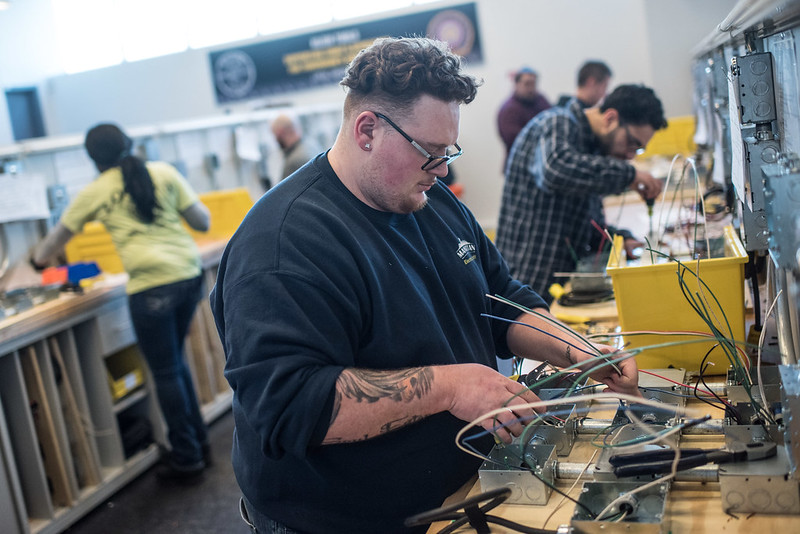The QueensWay is Good for Students and Learning; Let’s Get It Built

Queensway rendering (Trust for Public Land)
As Co-Principals of the Metropolitan Expeditionary Learning School (MELS) in Forest Hills, Queens, we place learning through outdoor experiences at the heart of our curriculum. We send our students out across the city and beyond, bringing in experts to give science, history, and other subjects real-life relevance.
Frustratingly, there’s a huge, unused outdoor classroom sitting right in our backyard. Bureaucratic indecision has stymied progress on turning the QueensWay, a railway line abandoned 60 years ago, into a thriving park.
It has now been a dozen years since we, ourselves, first got involved in intensive community discussions about it. We engaged a now-adult generation of former MELS students in shaping the future of the project together with many members of the local community.
Mayor Eric Adams did recently announce $35 million for the first phase of QueensWay. It’s for a section that adjoins our property and comes right up to the back of our school.
In the years since that past generation of our students first got involved in conversations about the future of the project, they’ve grown up, gone to college, and are now living productive adult lives. We, meanwhile, may have a few more gray hairs, but we haven’t given up hope on the tremendous potential of the QueensWay as an essential part of our students' learning experience. We’re glad the next generation of our students will get to benefit from the project while they’re still at school with us. It can’t happen soon enough.
The new entrance will give our students quick, safe access to the Forest Park area without having to walk across Union Turnpike, which is busy, has a small sidewalk, and is not conducive for large groups of students to safely walk. It will also give safe access to our school for many of our students who come from adjoining neighborhoods and currently have to cross other busy, wide, and dangerous roads like Woodhaven Boulevard and Metropolitan Avenue. The QueensWay is a safer option and connects neighborhoods and subway stops.
The outdoor classroom portion of the QueensWay will provide a unique opportunity for students to learn about the environment, sustainability, and urban design. We believe the project has the potential to inspire the next generation of environmental leaders, as well as landscape architects, scientists, gardeners, and so many other career pathways.
Our students will be able to explore the QueensWay and its unique mature forest of 60-year-old trees to learn about the plants and wildlife that call New York City home. They will also be able to learn about the history of the space and the communities that have used it in the past, as well as its current benefits of providing shade during hot summers and absorbing stormwater.
The QueensWay also offers a unique opportunity for our students to learn about the impact of human activity on the environment. By studying the QueensWay, our students will be able to see firsthand the effects of pollution, climate change, and other environmental challenges. It will help them understand the importance of sustainability and the need to take action to protect our planet.
The QueensWay will provide a space for our students to engage in experiential learning. They will be able to participate in service projects, such as planting trees, cleaning up litter, and improving the habitat for wildlife, ideally designing and caring for natural spaces that are directly connected to our school campus and to apply their learning in an authentic real-world format. These projects will help our students to develop a sense of responsibility for the environment and a commitment to making positive change in their community.
Finally, the QueensWay project offers an opportunity for our students to connect with the wider community. The QueensWay will be a public space that is open to all, and our students will be able to interact with people from different backgrounds and communities. This will help to foster a sense of community and understanding among our students, and it will help to build bridges between different communities in Queens. Let’s get it done.
***
Hillary Mills and Damon McCord are Co-Principals at the Metropolitan Expeditionary Learning School (MELS) in Queens.
***
Have an op-ed idea or submission for Gotham Gazette? Email This email address is being protected from spambots. You need JavaScript enabled to view it.
It’s Time for New York State to Finally Address Our Literacy Crisis and Ensure All Kids Can Read

Kids at school (photo: Michael Appleton/Mayoral Photography Office)
The literacy rate amongst children is at a crisis level: two-thirds of fourth-graders nationwide are unable to read proficiently. This represents a complete failure to prepare our students for the most basic of life skills, in part due to the continued use of flawed literacy instruction methods.
New York’s proficient reading rates of 30% are even worse than the national average. While other states are taking significant steps to address the crisis, New York has not acted, still permitting teaching practices that have been thoroughly debunked, rather than those aligned with the science of the reading brain.
New York is also failing its teachers. Our teachers-in-training and current educators are not properly instructed on how to teach reading. School districts continue to use harmful curricula, including debunked “three cueing” strategies that emphasize looking at pictures and guessing the words. A whopping 75% of K-2 and elementary and special education teachers use three cueing despite decades of data proving it’s ineffective.. The vast majority of our colleges of education are training future teachers how not to teach kids to read.
We know what works and simply have to stop using what doesn't. Children can and must be taught to understand and recognize letters and the sounds they make, so they can decode the words they encounter, and put words together to form sentences.
The 2000 National Report on Reading identified the five pillars of literacy instruction fundamental to teaching children how to read successfully. These pillars – phonemic awareness, phonics, fluency, vocabulary, and comprehension – underpin the language-based approach to instruction that is referred to as “structured literacy.” It emphasizes highly explicit and systematic teaching that has been proven successful in building literacy. This approach is even more critical to reaching kids with dyslexia and related learning disabilities. And here’s the thing: the brain research confirms it.
Mayor Eric Adams and the New York City Department of Education (DOE) recently announced the biggest overhaul to reading instruction in the public school system’s history, set to begin this fall. This initiative will require city schools to select one of three curriculums that follow the science of reading. This is a promising step, and the state should follow this lead.
This week, students, families and educators gathered in Albany again to urge the State Legislature, the State Education Commissioner, and the Governor to address these issues. We held our 8th Annual Dyslexia Awareness Day at the Capitol to share personal experiences and champion legislation to combat this literacy crisis.
One such solution is my “So All Can Read” bill to train future teachers in the science of reading. A recent report by the Education Trust - NY revealed that a major barrier to resolving this persistent problem has been the failure of our colleges of education to align their instruction with the science of reading. Other legislative solutions include a bill to screen incarcerated individuals for dyslexia and a dyslexia task force.
Inaction has consequences. Reading scores for Black, brown, and low-income students are even lower than the national average. Students who do not reach a fourth grade reading level are more likely to drop out of high school, be unemployed, live in poverty, or face incarceration. Serious policy changes are needed or we risk continuing to leave our children behind and fueling the school-to-prison pipeline.
***
Assemblymember Jo Anne Simon is a former teacher of deaf students (which requires language-based approaches), won a landmark disability rights case to secure testing accommodations for an individual with dyslexia on the NY Bar Exam, and served as president of the NY Branch of the International Dyslexia Association (now called Everyone Reading). On Twitter @JoAnneSimonBK52.
***
Have an op-ed idea or submission for Gotham Gazette? Email This email address is being protected from spambots. You need JavaScript enabled to view it.
How STEM Education Will Unlock New York’s Sustainable Future

Hands-on learning (photo: Michael Appleton/Mayoral Photography Office)
Here in New York, with 520 miles of coastline in New York City alone, we understand the urgency to address climate change and the need to act now. Today, the question is how do we achieve a successful and just transition to a decarbonized world?
The transition to a green economy is underway all over the country through advancements and growth in renewable energy. But, maintaining these energy systems will require a highly trained and educated future workforce with the skills and knowledge necessary to sustain and innovate mass change at scale, in ways that facilitate equitable opportunity and environmental justice.
Focused investment in interdisciplinary STEM education that connects to students’ lived experiences is a winning strategy to ensure we’re preparing for the workforce needs of a sustainable future.
Early exposure to STEM subjects produces impressive outcomes. Studies have shown that students who receive a STEM education are more likely to pursue higher education and careers in STEM-related fields lead to higher earning potential and greater job stability. Further, research demonstrates the effectiveness of hands-on place- and project-based learning for increasing students’ positive attitudes, levels of engagement, and confidence.
When schools teach through a sustainability lens to inspire student-driven projects, young people develop a stronger sense of agency to connect the dots across the environmental, economic, and societal dimensions of our shared challenges, with their action serving as a balm for their anxieties about the future.
In New York, the offshore wind sector alone is expected to catalyze billions of dollars in investment and create thousands of jobs over the next decade. This presents a unique opportunity to create pathways for young New Yorkers to become the professionals who will build and upgrade offshore wind farms for generations to come.
This community-changing economic opportunity starts in the classroom. Increasing access to place-based STEM education for students is essential to creating a robust and inclusive workforce capable of meeting the demands of the expanding offshore wind sector and representative of the communities it serves.
And we know: CELF is a nonprofit organization that works with K-12 teachers and students to advance environmental literacy through professional development and experiential learning. Our programs focus on teaching students of all ages about sustainability, social responsibility, environmental stewardship, and civic engagement, introducing them to conservation concepts and systems thinking skills from an early age through engagement and action in their communities. We are teaching real-world environmental sustainability concepts that are not often found in traditional K-12 classrooms but are critical to confront climate change.
Now we are ready to scale our approach to even more New York schools to equip students with the STEM skills and action competencies needed to build future careers in the green economy. That is why we have chosen to partner with Leading Light Wind – the only American-led offshore wind project in New York Bight, the offshore area.
Partnering with Leading Light Wind was an easy choice for us because of their commitment to educating and training the next generation of workers through partnerships with organizations such as the CUNY College of Staten Island, the CUNY Offshore Wind Advisory Network, the Brooklyn Navy Yard, Gotham Whale, the Waterfront Alliance, the New York City Economic Development Corporation, and others. Our partnership with Leading Light Wind will enable us to provide even more resources and opportunities to students interested in pursuing careers in the offshore wind industry.
As we move towards a clean energy future, it is imperative that we invest in bold plans that advance clean energy and that train, educate, and empower American workers and the local communities needed to get us there.
More cross-sector partnerships are critical to advance a holistic approach to combating climate change and building a clean energy future. From education to labor to environmental justice advocacy and more, we all must work together to increase equitable access to STEM education, provide training opportunities for students from all backgrounds, and support workforce development programs that will fuel a just energy transition.
Together, we can ensure that the region’s offshore wind sector is a catalyst for positive change, providing good jobs for workers and a brighter future for the region, and planet.
***
Tara Stafford Ocansey is Executive Director of the Children’s Environmental Literacy Foundation (CELF). On Twitter @TaraSOcansey & @CELFeducation.
***
Have an op-ed idea or submission for Gotham Gazette? Email This email address is being protected from spambots. You need JavaScript enabled to view it.




